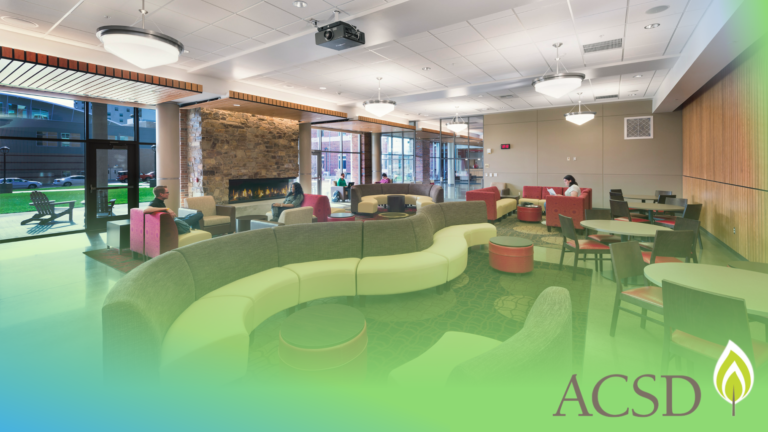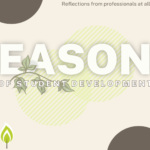![]() This content is brought to you by the Association for Christians in Student Development (ACSD), a volunteer membership organization committed to equipping and challenging faithful professionals to infuse their Christian faith into student development practice and scholarship. Thoughtful content such as this is made possible by volunteer contributions and the financial support of membership dues. Interested in becoming a member for more awesome content just like this? Join today by clicking here!
This content is brought to you by the Association for Christians in Student Development (ACSD), a volunteer membership organization committed to equipping and challenging faithful professionals to infuse their Christian faith into student development practice and scholarship. Thoughtful content such as this is made possible by volunteer contributions and the financial support of membership dues. Interested in becoming a member for more awesome content just like this? Join today by clicking here!
In the realm of higher education, creating an environment conducive to student success extends far beyond the classroom. One often overlooked yet profoundly impactful aspect of this environment is the residence hall. Residence halls serve as more than just living spaces; they are dynamic environments that foster social interaction, support networks, and a sense of belonging among students. According to Kurt Lewin’s field theory – which is often considered part of environmental psychology – behavior is a function of both the person and their environment (Lewin, 1951). The design and atmosphere of a residence hall lobby can significantly influence student behavior, encouraging positive interactions, relaxation, and community engagement, which can enhance a student’s overall college experience.
Vincent Tinto’s Theory of Student Departure (Tinto, 1993) proposes a student’s integration into the academic and social fabric of the institution is crucial to their persistence and success. This theory posits that successful integration involves a reciprocal relationship between the student and the institution. A comfortable residence hall plays a significant role in this integration process, acting as a central hub for social interaction, support, and community building. The institution must create environments that foster student engagement, while students must take active steps to participate in these environments. Tinto (1993) emphasizes the importance of academic and social integration in student retention, by suggesting students are more likely to persist in their studies if they feel connected to both the academic and social components of college life.
The Role of Residence Halls
Residence halls and their lobbies are one of the primary spaces where residential students can begin to feel this sense of belonging and integration. These areas are not just transitional spaces but are pivotal in shaping students’ experiences and aiding their transition into college life. As institutions consider budget requests, future funding, and if that couch should be cleaned or replaced, it is important to consider how a well-designed, comfortable residence hall lobby can impact student success. If this has not convinced you enough, here are six reasons to consider the impact of a well-designed residence hall lobby:
- Facilitating Social Integration – Social integration is a key component of Tinto’s theory (1993). A comfortable lobby encourages students to gather, interact, and form relationships. Comfortable seating arrangements, warm lighting, and inviting decor can create an atmosphere where students feel at ease to socialize. This interaction is particularly crucial for first-year students who are in the initial stages of establishing their social networks. Informal gatherings, study groups, and community events held in the living area can foster a sense of community and belonging, which Tinto identifies as essential for student retention.
- Providing a Supportive Environment – The transition to college can be challenging, and students often need support during this period. A residence hall lobby can serve as a supportive environment where students can seek help and advice. Staff offices located near or within the lobby area can provide easy access to Resident Assistants (RAs) and other support staff. Bulletin boards and digital displays can disseminate important information about campus resources, events, and support services. This accessibility to information and support can significantly ease the transition for new students, aligning with Tinto’s (1993) emphasis on the importance of institutional support in student retention.
- Encouraging Academic Engagement – A thoughtfully designed lobby can also encourage academic engagement. By providing spaces for collaborative study and group projects, residence hall lobbies can become extensions of the educational setting. Comfortable seating, ample lighting, and quiet corners for focused work can make the lobby an appealing place for academic activities. This blend of social and academic uses reinforces Tinto’s idea that successful student integration involves both social and academic engagement. When students see their peers studying and engaging academically in shared spaces, it can motivate them to do the same.
- Fostering a Sense of Ownership and Responsibility – When students feel a sense of ownership over their living spaces, they are more likely to take responsibility for their environment and their community. Involving students in the design and decoration of the residence hall lobby can foster this sense of ownership. Whether it’s through student artwork, input on furniture selection, or involvement in planning events held in the lobby, these opportunities can empower students and make them feel more connected to their living space. This sense of responsibility and connection can enhance their overall integration into the college community. Successful integration into social systems of a college is crucial for student retention and success (Tinto, 1993). By promoting a sense of ownership and responsibility in residence halls, institutions can help students build stronger social connections and a deeper commitment to their college community, ultimately reducing the likelihood of departure.
- Promoting Well-being – The design and ambiance of a residence hall lobby can have a significant impact on students’ well-being. Stress and anxiety are common among college students, especially those in their first year. A well-designed lobby with natural light, plants, comfortable seating, and calming colors can create a welcoming and relaxing atmosphere. This environment can provide a respite from the academic pressures and hectic pace of college life, contributing to better mental health and well-being. Additionally, a thoughtfully designed lobby can offer spaces for reflection, meditation, and spiritual activities, fostering spiritual growth alongside mental well-being. According to Tinto’s (2012) theory, supporting students’ overall well-being is integral to their success and retention.
- Enhancing Accessibility and Belonging – A comfortable and well-designed residence hall lobby should also be inclusive and accessible to all students. This includes ensuring that the space is physically accessible to students with disabilities and that it caters to a diverse student population. Inclusive design features such as wide doorways, ramps, and accessible furniture can make the lobby welcoming for everyone. Additionally, creating spaces that respect and celebrate cultural diversity can help all students feel included and valued. Inclusivity in communal spaces reinforces Tinto’s idea of creating an environment where every student can find their place and feel connected to the institution.
The residence hall lobby, often viewed merely as a passageway, holds significant potential as a space for fostering student integration and success. By aligning with Tinto’s Theory of Student Departure, higher education institutions can recognize the critical role of residence hall lobbies in promoting social and academic integration, providing support, and enhancing overall student well-being. Investing in the design and functionality of these lobbies can yield substantial benefits in terms of student retention and success. As colleges and universities continue to seek ways to improve the student experience, the importance of a comfortable and inviting residence hall lobby cannot be overstated.
Practical Ways to Refresh a Residence Hall Lobby
- Update Furniture and Seating Arrangements:
- Replace old or uncomfortable furniture with modern, ergonomic seating options.
- Introduce a mix of seating arrangements, including couches, armchairs, and study tables to accommodate different activities and group sizes.
- Consider modular furniture that can be easily rearranged to suit various events and needs.
- Enhance Lighting:
- Install warm, inviting lighting fixtures to create a cozy atmosphere.
- Use a combination of ambient, task, and accent lighting to cater to different activities, such as studying, socializing, and relaxing.
- Incorporate natural light as much as possible by using sheer curtains or blinds that can be adjusted throughout the day.
- Incorporate Student Artwork and Decor:
- Display student artwork and creative projects to personalize the space and foster a sense of ownership.
- Allow students to participate in choosing decor elements, such as wall colors, art pieces, and decorative accents.
- Rotate the displayed artwork regularly to keep the environment fresh and engaging.
- Create Designated Zones for Different Activities:
- Designate specific areas for studying, socializing, and relaxation to cater to diverse needs.
- Set up quiet study corners with comfortable chairs and good lighting for focused academic work.
- Design communal spaces with larger tables and seating arrangements for group activities and social interactions.
- Add Greenery and Natural Elements:
- Introduce plants and greenery to the lobby to enhance aesthetics and improve air quality.
- Use natural materials, such as wooden furniture and stone accents, to create a calming and welcoming environment.
- Incorporate biophilic design elements, such as water features or nature-inspired art, to promote well-being.
- Improve Accessibility and Belonging:
- Ensure the lobby is physically accessible to all students by incorporating features like wide doorways, ramps, and accessible furniture.
- Design the space to cater to diverse cultural backgrounds and needs, creating an inclusive environment where all students feel welcome.
- Include signage in multiple languages and provide information about campus resources and support services.
- Upgrade Technology and Amenities:
- Provide charging stations and comfortable workstations to support students’ academic needs.
- Install digital displays to share important announcements, event information, and campus news.
- Add amenities like water bottle refilling stations, coffee stations, and vending machines to make the space more convenient and comfortable.
- Host Events and Activities:
- Organize regular events and activities in the lobby to encourage student participation and engagement.
- Use the lobby as a venue for workshops, social gatherings, and study sessions to foster community building.
- Encourage student organizations and clubs to use the lobby for meetings and events, enhancing its role as a central hub for student life.
By implementing these practical changes, institutions can create a vibrant and functional residence hall lobby that supports student success, fosters community engagement, and enhances overall well-being, aligning with the principles outlined in Tinto’s Theory of Student Departure.
References
Lewin, K. (1951). Field theory in social science: Selected theoretical papers (D. Cartwright, Ed.). Harper & Row.
Tinto, V. (1993). Leaving college: Rethinking the causes and cures of student attrition (2nd ed.). Chicago, IL: University of Chicago Press.
Tinto, V. (2012). Completing college: Rethinking institutional action. Chicago, IL: University of Chicago Press. https://doi.org/10.7208/chicago/9780226804545.001.0001







